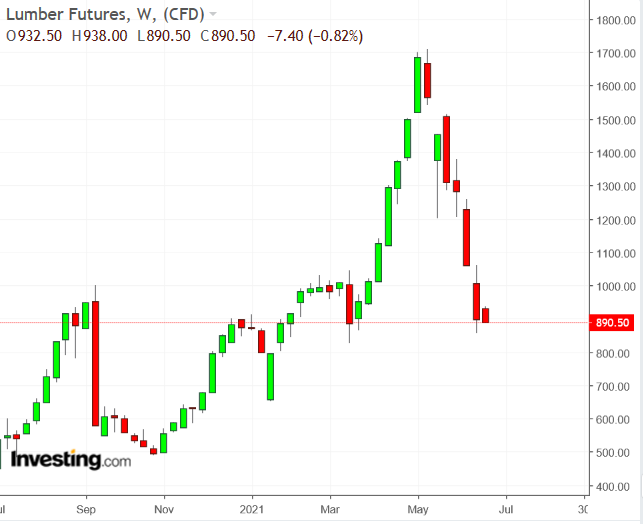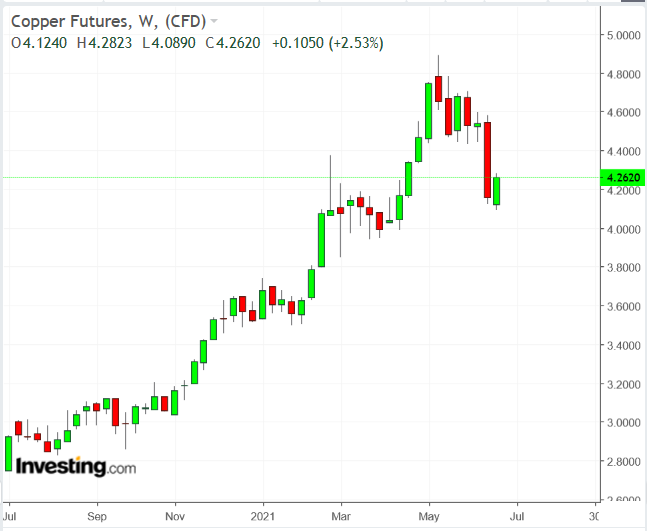Bank of America, Morgan Stanley, Nvidia and Dollar Tree rise premarket
Lumber has given up nearly all of its 95% gain from earlier in the year after US builders snuffed the rally in the home construction commodity by simply choking activity.
Since reaching an all-time high of 927,000 units in October 2020, the annual pace of new home sales in the United States has fallen around 20%. Reason: Fewer houses have been coming on the market each month, despite roaring demand.
Part of it has to do with pricing, which has hit record highs month after month. The Mortgage Bankers Association estimated that the average loan size for new home applications again rose in April, to $384,000, from $377,434 in May.

The other reason is the deliberate slowdown in activity by builders unable to stomach the ludicrous spike in prices of lumber, which reached above $1,711 per 1,000-foot board at the peak of its rally six weeks ago—up 95% since Dec. 31 and 417% higher from a year ago.
At Tuesday’s settlement, that same 1,000 foot board of lumber was just a touch above $890—just 2% higher from where it began 2021.
The crunch in timber prices came as the US Department of Commerce reported last week that permits for future home construction hit a seven-month low. Housing completions declined while the number of homes authorized for construction, but not yet started, rose to the highest level since 1999, indicating supply will likely remain tight for a while.
Just about three years ago, lumber fetched as low as $300 to $500 per 1,000 foot board. Then, the Trump administration slapped a 24% tariff on softwood lumber imported from Canada, the largest producer of the commodity in North America. That sent prices above $600 the first time in mid-2018.
The perfect storm came in July 2020, when supply bottlenecks from the pandemic squeezed delivery times for an already limited commodity. Lumber hit above $1,000 for the first time in September and continued making new four-figure highs through early May.
Until they caved in mid-May, lumber over the past year added $35,872 to the price of an average new single-family home and $12,966 to the market value of an average new multi-family home in the United States, according to the National Association of Home Builders.
The ability of US builders to force lumber prices down as much as they did is a rare win in the post-pandemic age.
Many other raw materials remain at lofty heights, with copper and iron ore not too far from record highs; corn, wheat soybeans near eight-year peaks; and oil at more than two-year highs.

For months, manufacturers have complained about rising costs in the tight supply of almost everything—from microchips needed across industry to the resin required for making plastics and cardboard cartons—as an economy expanding from months of COVID-suppression now finds broken supply chains and other logistical bottlenecks in its way.
While the plunge in lumber’s value may not do much in bringing US house prices down, it does somewhat back the Federal Reserve’s narrative that the surge in commodity prices and resulting inflation amid the current economic rebound now is “transitory.”
That theme was expounded again on Tuesday by Fed Chairman Jerome Powell and his retinue of central bankers in speeches to Congress and the public as they continued to tell Americans that there was nothing to be unduly worried about on the economy.
This, despite the Fed’s favored benchmark for inflation—the core Personal Consumption Expenditure, or PCE, Index—expanding at a multiyear high of 3.1 percent in April, compared to a year ago. That is 1.5 times greater than the central bank’s own target of 2% per annum for inflation.
The more popular Consumer Price Index, meanwhile, grew by 5.0% in the year to May, its fastest since 2008.
The Fed last week indicated that there could be two hikes before 2023 to bring current interest rates of between zero and 0.25% to 0.6%, and a scale back in the central bank’s $120 billion of monthly stimulus as well, when appropriate.
But on Tuesday, Powell, testifying before the US Congress, and New York Fed President John Williams, during a Bloomberg interview, said the central bank will be a lot more patient with policy changes as whatever inflation pressure seen in the country was expected to dissipate as the economy continued to recover.
So, back to lumber: How much lower can prices go?
Paul Jannke, of Forest Economic Advisors, a highly-regarded industry expert, has predicted $800 levels or slightly lower by July.
Investing.com’s own Daily Technical Outlook continues to hold a “Strong Sell” on lumber, with its top two modeling variants—Fibonacci or Classic—suggesting an immediate bottom of between $828 and $797.
Under the Fibonacci model, lumber could move down in a range that begins at $878 and proceeds to $859, before sliding to $828.
In the Classic mode, the bottom could first reach $877, then $828 before moving down to $797.
Disclaimer: Barani Krishnan uses a range of views outside his own to bring diversity to his analysis of any market. For neutrality, he sometimes presents contrarian views and market variables. He does not hold a position in the commodities and securities he writes about.
